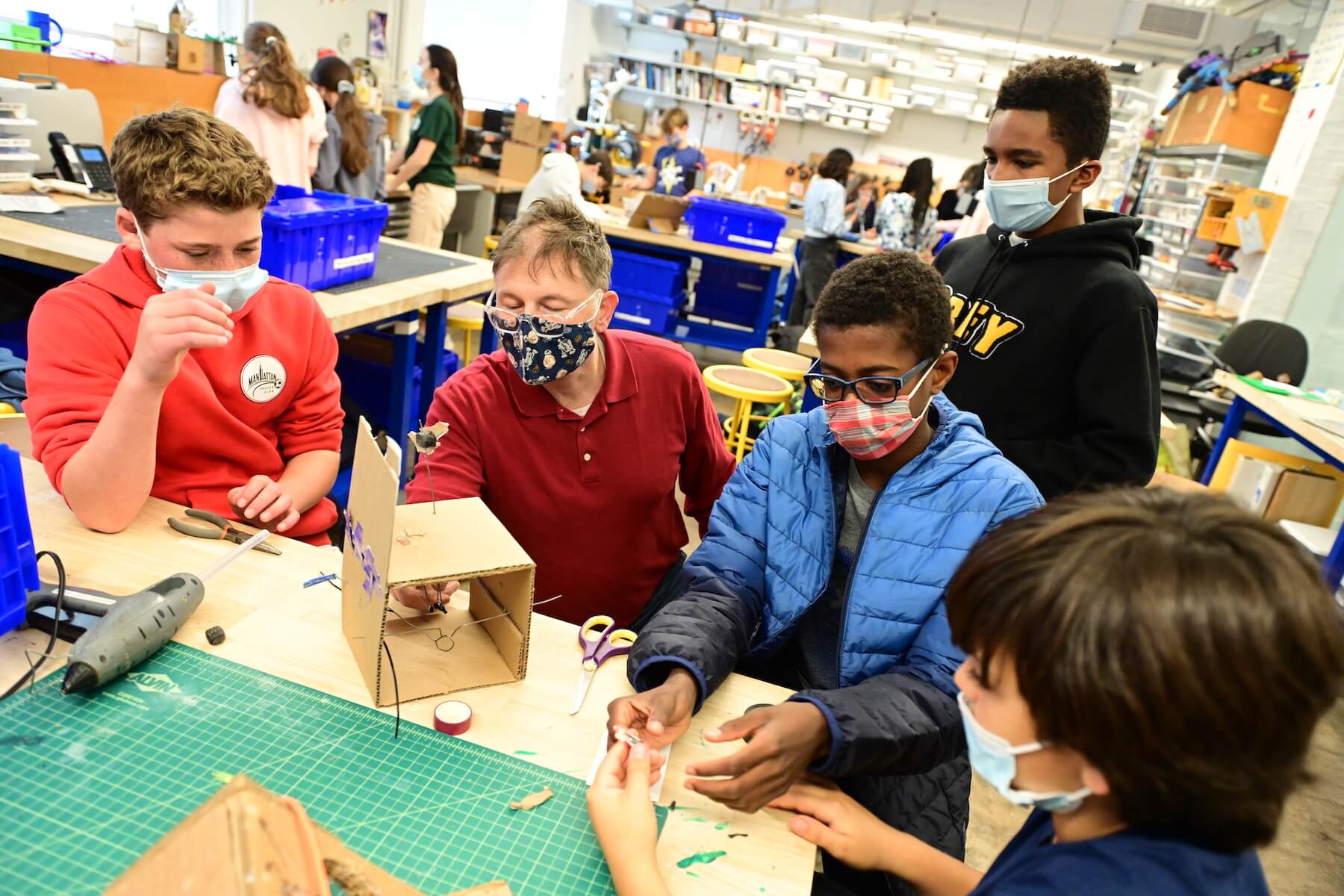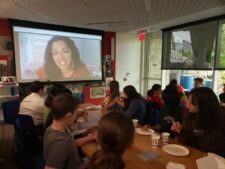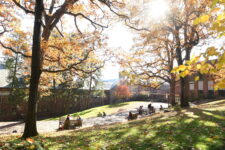The 7th Graders enter their classroom and head directly to their work stations. With determined focus, they begin tinkering with the intricate, animated scenes they are constructing out of cardboard. The classroom, located in the Design Studios on the Fieldston campus, is bright, open, and filled to the brim with materials, tools, and partially constructed projects. John Baglio, Fieldston Middle Science and Engineering Teacher, moves around the space, admiring students’ work and encouraging them to try new ideas and especially to self-direct. “My goal for all of my students is to increase a sense of agency,” says Baglio.
Baglio heads the Fieldston Middle Engineering program, which began nearly eight years ago. Since that time, hundreds of students have experienced the thrill of generating an idea, creating a plan, and building something that is entirely their own.
At the Ethical Culture Fieldston School, progressive education is guided by ten tenets: Education must be responsive, relevant, ethical, experiential, interdependent, challenging, inclusive, empowering, healthy, and playful. The Fieldston Middle Engineering Program exemplifies these tenets through a robust curriculum that keeps students highly engaged, excited, and eager to learn.

Responsive
While the pandemic altered the curricular plan for many departments, it threatened to derail engineering entirely. Students were no longer able to work in the beloved Design Studios, and trying to teach inherently hands-on assignments posed a unique challenge for Baglio. Shortly after the pandemic took hold, Baglio decided he still wanted his students to build things, even with everyone sheltered at home. He introduced an assignment to his students that asked them to craft something out of paper — and he immediately ran into a roadblock. Many students didn’t have any paper at home — or any other crafting materials — and families did not feel comfortable visiting the store.
“I had this revelation that, if I want kids to do hands-on anything, I am literally going to have to give them everything.” Baglio collaborated with a company in California that makes educational electronics for kids. He spent several months sourcing materials and planning what would go into each box. Before the start of the 2020–2021 academic year, Baglio sent every engineering student a toolkit that included a Micro:bit (a miniature, programmable computer), a sound recorder, and craft supplies such as pompoms, glue, tape, popsicle sticks, paper, and rubber bands. Instead of giving up on the idea of teaching hands-on engineering remotely, Baglio met the demands of the moment, providing the means for his students to create exciting, innovative projects from the safety of their homes.
Relevant
In the spring of 2021, Baglio tasked his 7th Graders with a unique and topical challenge: using materials found at home — along with their engineering toolkit — to design a container that could keep a COVID-19 vaccine safe from physical impact, light, and changes in temperature while in transit. In place of the vaccine, students used the Micro:bit, which is capable of sensing these types of environmental changes.
At the time of the assignment, the COVID-19 vaccines had recently been introduced to the public, and there was considerable discussion in the media surrounding how to safely transport the vaccines to remote locations. It was an opportunity for 7th Graders to practice advanced engineering skills inspired by a significant moment in time.
Ethical
Ethics are at the heart of an ECFS education. In the Fieldston Middle Engineering program, the study of ethics is on display both in the curriculum itself and in the way the projects are executed.
Baglio is currently working on putting more environmentally safe projects into the curriculum and ensuring that existing projects are as sustainable as possible — and that our community maintains its ethical stance on supporting our planet. “We do our best to minimize waste in everything we do,” Baglio explains, and items from projects are recycled or reused whenever necessary.
Baglio also plans to combine the lessons he teaches his students on sustainability with hands-on engineering education. This year, 8th Graders will undertake a new project called Future Cities, in which they will design a model city with a circular economy where no waste is generated. Students will learn not only how to construct a comprehensive model, but also the importance of planning for a more sustainable future.
Experiential
“This class is very hands on by definition,” explains Baglio. For their first project of the year, 7th Graders build a fully functioning automata from cardboard, foam, and other craft materials. The students work in teams to brainstorm an idea, develop a construction plan, and build a machine that displays a moving scene when a handle is turned. It’s a complex engineering process, which is one reason Baglio chooses to begin the year with it. “I do this project first because it forces them to iterate — it almost never works right the first time. They have to work through it, and they experiment with actual mechanisms,” explains Baglio.
I almost always err on the side of letting them find out on their own. Mess around. Make mistakes.
While Baglio is always nearby in the classroom to help students with specific questions as they work, he is also committed to giving them the space they need to learn through experimentation. “I always grapple with how much to tell the students and how much they should find out on their own,” says Baglio. “I almost always err on the side of letting them find out on their own. Mess around. Make mistakes.”
Interdependent
“Where is the cat?” one student calls across the table.
“Did you check over there?” another student responds. Suddenly, an arm reaches across the table, cardboard cat in hand.
“Here you go!”
The students are working together to create their automata, which will eventually display a cat walking along a path. Once the missing cat is found, the students ask each other a more complex question: “Do we need to redo this?” The wheel that is meant to spin and animate their automata isn’t working, and the students are considering going back to the drawing board. As they discuss, they continue to work — one is cutting a square of cardboard; another student is attaching a paper handle to a wooden stick. Each student is reliant on the anothers to complete the project — experiencing all the triumphs and challenges along the way. Group projects are the norm in the engineering classroom. Students don’t just learn critical engineering skills; they also learn the invaluable life skills of collaboration and teamwork.

Challenging
One way that Baglio challenges his students is by not providing them with detailed instructions on any given assignment. When Baglio creates models or samples of projects, he keeps them purposefully vague so that students may dream up their own designs without influence. The example-automata Baglio displayed for 7th Graders was a simple white box with a wheel and a stick — he then directed his students to turn around and build something that both functioned fully and told a story through its design. Not only are engineering classes meant to be very hands on, but the projects are designed to allow the students to learn as they go and to challenge them to learn from their mistakes. The point is to fail and to try again — iterating until an idea becomes a reality.

Inclusive
Engineering is — intentionally — a class that is light on both reading and writing. For any students who struggle with these modes of learning, Engineering offers them the opportunity to absorb information in a different way. Students who think with their hands, or who prefer a more kinesthetic style of learning, are given the chance to excel in a class where the early phases of a project revolve around drawing, prototyping, model building, and experimentation.
Baglio also makes a concerted effort to foster inclusivity and diversity in his classroom.
“Research on what invites in and what pushes away people who are traditionally underrepresented in the STEAM fields — women and people of color — informs my teaching,” Baglio explains. “I teach an ungraded class that works in a collaborative way that involves some level of creativity and personal expression into each project for a reason. These things, as opposed to an individualistic, graded class that is competitive in nature and rewards students for their achievement of a single idealized product, are conducive to an inclusive environment.”
Empowering
“The secret agenda of my class is not really to turn students into professional engineers but to use engineering as a way to cultivate a sense of agency in my students,” says Baglio. When students learn that they can create something by designing it and building it themselves, or learn that they have the ability to modify or fix physical objects, they develop a sense of agency over not just their learning, but their lives. “They get the idea that they can change their life, their circumstances, their health, and their world for the better,” explains Baglio.
The secret agenda of my class is not really to turn students into professional engineers but to use engineering as a way to cultivate a sense of agency in my students.
Healthy
“If sitting is the new smoking, there is not much smoking in my class,” jokes Baglio. Throughout every Engineering class, students can be seen standing at work stations, darting across the room looking for materials, or circling up with each other to discuss a project. Students are rarely sitting, and almost never using screens. Engineering offers 7th and 8th Grade students the opportunity to get up out of their chairs and engage with their work in a much more hands-on, active way.
Playful
At first glance, the Engineering classroom in the Design Studios could be mistaken for a toyshop. The counters are lined with playful cardboard cutouts of cats and boats and fish. There are gears and tools and colors galore. As Baglio puts it, “This room is what I imagine the inside of my brain looks like.”
The space certainly fosters creativity and playfulness. Throughout his classes, Baglio guarantees as little structure as possible with lots of time for students to iterate and play around with whatever assignment they may be working on. The result? Students enjoy a learning experience that both challenges and delights them. “Kids aren’t given enough time to play — this class is a lot of playing,” says Baglio.



